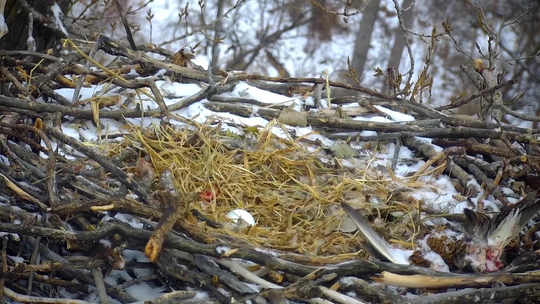|
February 18, 2021
 
February 18, 2021
We have EGG-citing news!
Thanks to the EGG-cellent work of the DNR Nongame Wildlife Program and the technicians in MNIT, you can get an up-close view of the first 2021 EGG in the DNR EagleCam nest!
After the recent harsh weather, capitol insurrection, pandemic, etc., this is truly EGGs-hilarating!
And that’s no EGGs-ageration!
So much excitement on the nest this week! On Sunday, Valentine's Day, the male brought a mallard duck in for his mate. After pulling off most of the feathers (which they use to line the nest with for soft warmth) he ate some, then shared it with the female. Once they both had their fill, they flew off for a while and left the "nestovers" nearby.
On Monday, a juvenile bald eagle came into the nest to take advantage of the leftover duck. Eagles are scavengers and this provided a good meal for the hungry young bird. Eventually, it took the duck head and flew away with it! It did leave most of the feathers, which will serve as soft, warm nesting material for the nest.
For most of the day on Tuesday the pair was visiting the nest together. They were fiddling with sticks, bringing in and moving grasses and feathers, and enjoying food. Late in the afternoon the female began panting and slowing down her breathing. As she entered a trance-like state, she laid her first egg of the season at 4:37 pm., February 15th. Now, we wait to see how many more she will lay before the formal incubation begins. During this time, both parents take part in the incubation of the egg and might leave it uncovered for a short while. Don't be alarmed! This is normal, even in cold weather for them to lightly cover the egg with grasses and leave the egg temporarily. Unless the egg is left for hours at this "delayed incubation" stage, the egg will not freeze and should hatch without any trouble, in about 35 days. In the coming days, the female will lay one to three more eggs - about two days from each subsequent egg. There will be increased activity from now until after the chicks hatch, as the parents feed mostly in the nest, bringing prey items to each other while incubating the eggs.
Enjoy these precious moments from the EagleCam and don't be afraid to venture outdoors to see wildlife in the winter! Winter is a great time to view birds, especially because there are fewer leaves on the trees and it's easier to see them hopping and flying around our beautiful state.
We want to thank you for your continued support of the Nongame Wildlife Program. We rely on your contributions and we just couldn't do our important work without your support. YOU make our program and we thank you!
A juvenile visiting the nest -- E2, perhaps?
|